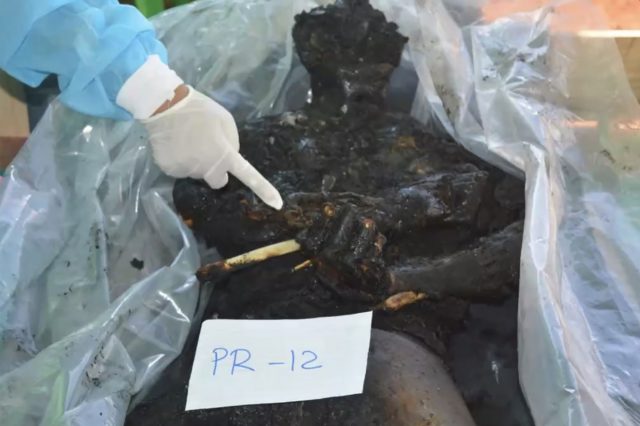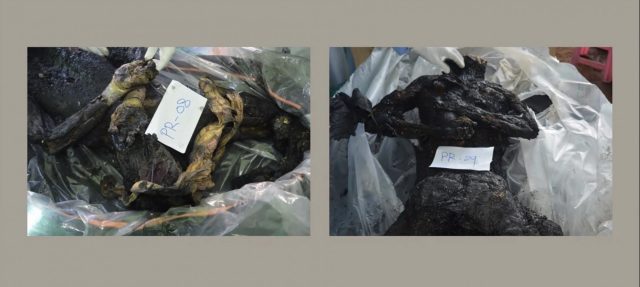Doctor says victims of Karenni State massacre ‘murdered in cruelest, most inhumane manner’


Photograph presented at the online press conference on January 3 show a burned body examined by doctors following the December 24 massacre Hpruso Township, Karenni State (Screengrab)
New evidence surfaces implicating the Myanmar military in the killing of nearly 50 people and the destruction of evidence in Hpruso Township
By Myanmar Now
Warning: This report contains disturbing images
Families of the victims of a massacre in Karenni (Kayah) State’s Hpruso Township and a doctor who carried out post-mortem examinations of their remains have disclosed new details concerning the dozens of people slain and burned by the military on December 24.
The National Unity Government (NUG) and the Karenni State Consultative Council (KSCC) shared photos, medical records and evidence gathered from the site of the crime in an online press conference on Monday.
Bo Bo, the deputy township police chief of the Karenni State Police Force—an anti-junta law enforcement network made up of police officers taking part in the CIvil Disobedience Movement (CDM)—speculated that up to 49 people could have been killed on the Moso-Kwaing Ngan road near Moso village, some two kilometres northwest of Hpruso town.
Myanmar Now initially reported that at least 35 charred bodies and multiple burned vehicles were found by members of the resistance group the Karenni Nationalities Defence Force (KNDF) at the roadside site early on Christmas morning. They accused Myanmar army troops present in the area of committing the massacre.
Bo Bo said on Monday that the group of doctors who carried out the post-mortem examinations had managed to carry out autopsies on 31 of the bodies, but that the others were completely destroyed in the fire, crumbling to ashes when touched, and collected in three body bags.
Twenty-six of the victims who could be examined were identified as male, including two boys estimated to be under 17 years old. Six were determined to be female, including a young girl under the age of 12, Bo Bo said.
A doctor who performed autopsies on the bodies and who spoke at the press conference on the condition of anonymity confirmed the Karenni police officer’s summary and added that the girl would have been between the ages of 10 and 15.
“I think everyone can imagine whether it would have been possible that a young child under the age of 18 tried to shoot them,” said the doctor, who is also taking part in the CDM, commenting on the unlikelihood that the victims could have instigated the attack by opening fire on the soldiers believed to have murdered them.
“They killed innocent civilians and burned the bodies to destroy the evidence of their crime,” he added.
The doctor also confirmed that several of the bodies he examined had their hands tied behind their backs, were gagged, or had perforations to their chests and lungs.
He added that they only managed to retrieve the bodies three days after the incident because the military continued to fire artillery shells at anyone who attempted to enter the area.
Laboratory analysis had not yet determined if the victims were burned alive.
The doctor stated that they could not confirm if the perforated wounds found on the bodies were caused by bullets or sharp objects.
“We can imagine how much pain they must have been in before they died just by looking at the evidence,” he said.

Photographs presented at the online press conference on January 3 show the hands of two burned bodies tied behind their backs following the December 24 massacre in Hpruso Township, Karenni State (Screengrab)
Describing the experience of carrying out the post-mortem examinations, he said, “That was the day I saw dead bodies en masse who were murdered in the cruelest and most inhumane manner I have ever seen in my entire life.”
Along with the bodies, six trucks, two civilian cars, two tractors and six motorcycles were also burned, Karenni State police officer Bo Bo said, adding that the bodies they were unable to examine were found wedged between the three trucks, which were carrying barrels of oil.
He added that two of the bodies which were able to be identified were confirmed to be staff members of the international aid group Save the Children, which had reported their staff missing following the incident. Four other bodies were determined to be members of a Border Guard Force (BGF), a militia operating under the junta.
“That was the day I saw dead bodies en masse who were murdered in the cruelest and most inhumane manner I have ever seen in my entire life – a doctor who carried out the post-mortem examinations.”
The BGF members had been seen in Moso village at 11am on December 24, and had reportedly attempted to negotiate the release of civilians being held by the military. It was later reported that they had been executed.
Family members of the victims also attended Monday’s online press conference.
The wife of Moso resident Bu Reh confirmed that a tractor found destroyed in the fire was the one that her husband had been driving when he left their home.
Crying, she explained that Bu Reh had left on the tractor at around 7am and never returned.
“There had been shooting that day and I had to run away like an animal,” she said, “Our family is going through a lot of pain. We haven’t been able to eat and we spend our days crying. It’s so upsetting because the children are still so young.”
She added that Bu Reh was only carrying a knife as he had been planning to gather bamboo, so it was not possible that he tried to shoot at the soldiers, which has been implied by the military.
The military council released a statement on the same day as the massacre that they fired shots at the seven “suspicious” vehicles because they refused to stop when they told them to do so. The junta alleged that people in the vehicles shot at the soldiers from the trucks and they were “captured dead” after a shootout. The statement did not address the reports of murder or the burning of evidence.
Junta information officer Gen Zaw Min Tun told BBC Burmese that 25 members of the anti-junta resistance group the People’s Defence Force died in the incident, and that among them was one woman.
The families of the victims, the NUG leadership, and the Karenni State police officer collectively rejected the military’s claims that the victims of the massacre were PDF fighters who refused to stop their vehicles for the junta troops. They maintain that they were civilians.
Aung Myo Min, the NUG’s human rights minister, pointed to the fact that all of the bodies and vehicles were burned in a single location, indicating that the military was likely attempting to destroy evidence of crimes that occurred there.
In response to a family member demanding justice for their slain loved ones, Aung Myo Min promised that the NUG would file a case against the junta in the International Criminal Court, as well as send details of the massacre to the Independent Investigative Mechanism for Myanmar established by the UN’s Human Rights Council.
“I can sympathise with the victims and we are doing our best to take legal action against the military council and the leaders of the coup regime who are most responsible for these atrocious crimes,” he said.
Original Post: Myanmar Now

